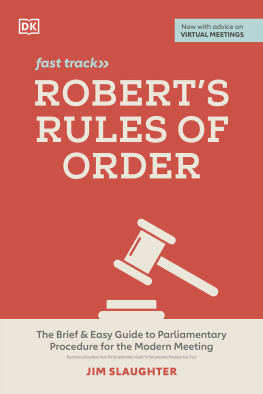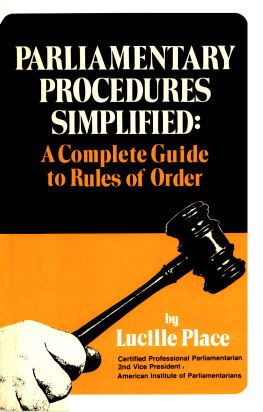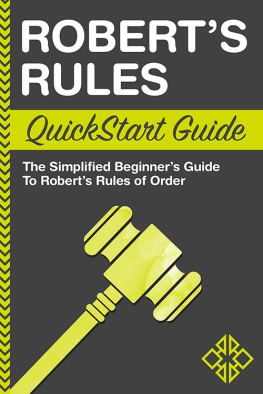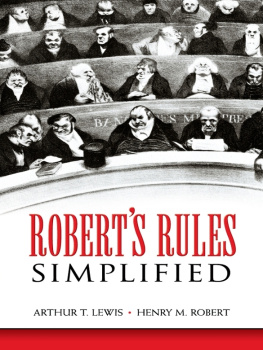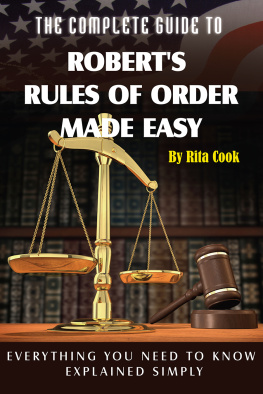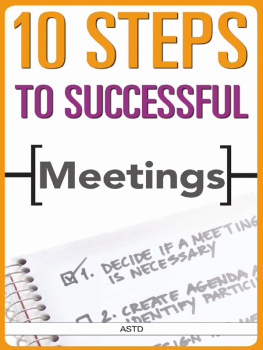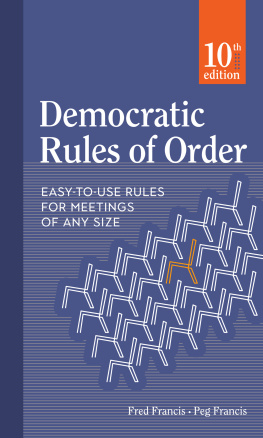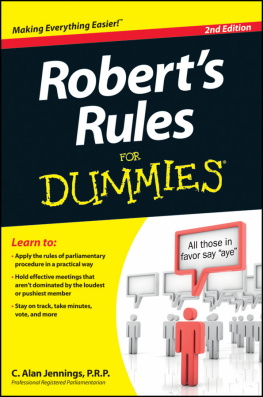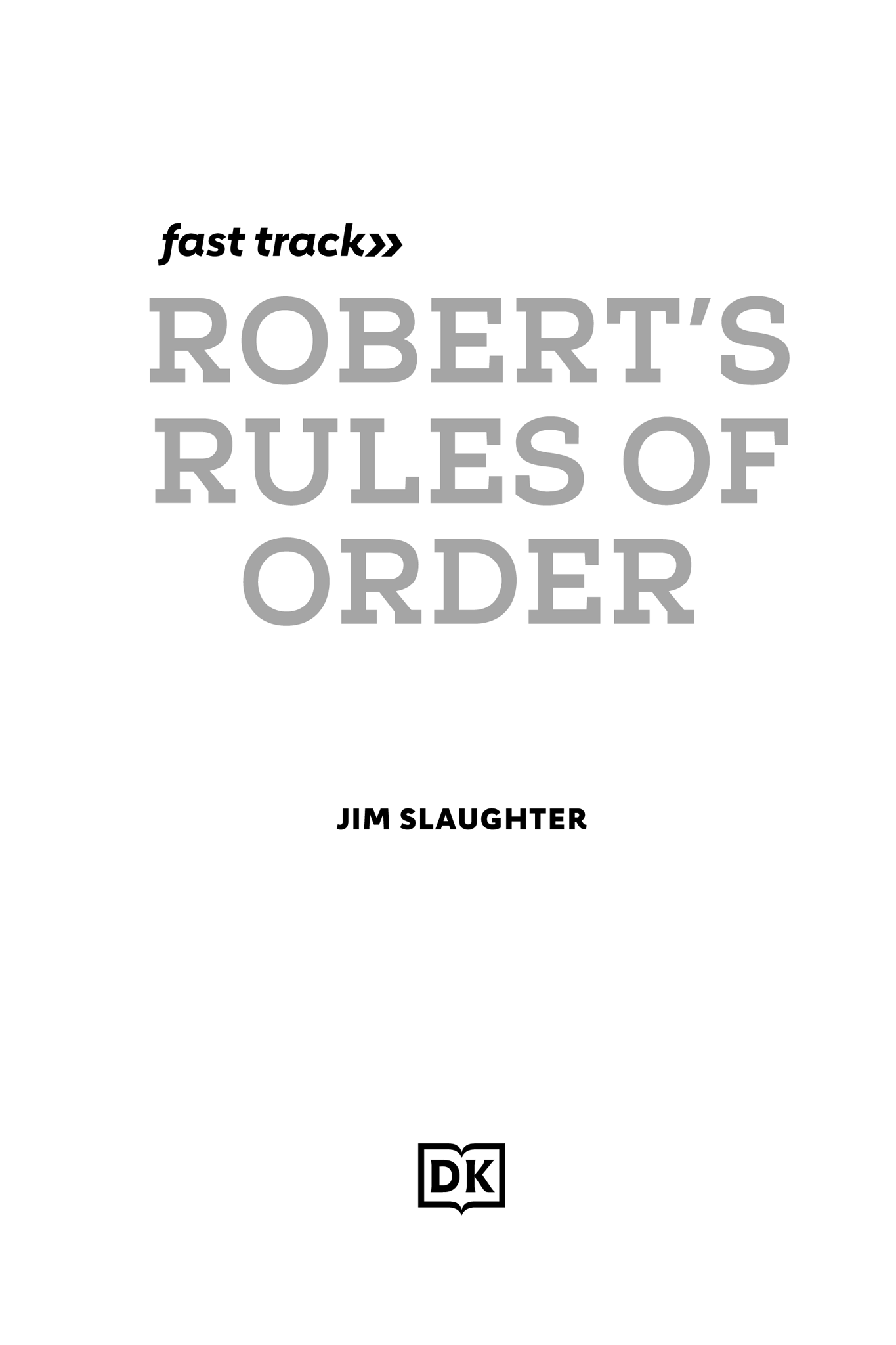CONTENTS
Landmarks
Contents
g
How to use this eBook
Preferred application settings
For the best reading experience, the following application settings are recommended:
- Orientation: Portrait
- Color theme: White background
- Scrolling view: [OFF]
- Text alignment: Auto-justification [OFF](if the eBook reader has this feature)
- Auto-hyphenation: [OFF](if the eBook reader has this feature)
- Font style: Publisher default setting [ON](if the eBook reader has this feature)
- In Settings, change the font size to a size you are most comfortable with.
g
Chapter 1
What Is Parliamentary Procedure?
Because you picked up this book (and are still holding it), you must have some interest in meeting procedures. Even so, it might help to start with some explanation. The term parliamentary procedure is likely broader than you think. Thats because the phrase encompasses everything that goes into running a legal and effective meeting, including these procedures:
- Giving proper notice of the meeting to members
- Waiting until enough members show up before starting the meeting
- Discussing and voting on issues at the meeting
All these considerations and more fall under the heading parliamentary procedure .
If you attend business meetings, you should at least learn the basics of parliamentary procedure. For one thing, state laws and association governing documents often prescribe the rules organizations must follow to transact business. As a result, ignoring or incorrectly applying parliamentary procedure can lead to embarrassment, hard feelings, and even lawsuits. But the benefits of a well-run meeting go far beyond legal concerns. Proper procedure can turn long, confrontational meetings into short, painless ones. If youre a leader, thats a good way to keep members happy.
What Parliamentary Procedure Is Not
Its almost easier to discuss what parliamentary procedure is not, rather than what it is . Parliamentary procedure is not just a book called Roberts Rules of Order . Roberts is the best-known book on parliamentary procedure, but there are others. Depending on your specific group, Roberts might not even be relevant. For instance, organizations of physicians and dentists often use some version of a book entitled The Standard Code of Parliamentary Procedure as their guide to meetings. State legislatures often fall back on Masons Manual of Legislative Procedure . Such groups dont talk about or refer to Roberts Rules of Order. Its just not their book.
With that said, I spend much of this book discussing Roberts. Thats because, without question, its the 800-pound gorilla of the parliamentary world.
A parliamentary authority is a book on meeting procedure that is followed because of an adopted rule or bylaws language. Among organizations with a parliamentary authority , most use (or at least claim to use) Roberts.
Roberts Rules and parliamentary procedure are viewed as one and the same by most of the public. Some courts have held that Roberts can be relied upon even without a required parliamentary book. The fact that Roberts is the most popular and easiest-to-locate book on parliamentary procedure argues strongly in its favor as a parliamentary authority .
Parliamentary procedure isnt just about motions either, such as the motion to Adjourn or for the Previous Question. Sure, motions are how business is transacted in a formal meeting. But motions only take up about a third of the current Roberts. The rest of the book is a wonderful resource for anyone who has to spend time in meetings.
For instance, theres a chapter on how to run a meeting if youve never presided over one before (aptly named Suggestions for Inexperienced Presiding Officers). One chapter describes how to take minutes, noting that you dont need to write down what people say, just what was done (see ). Theres even a set of sample minutes. Another chapter explores options for dealing with problem members or guests. A final chapter discusses how to remove an elected officer (if youre an officer, take comfort in knowing that hardly anyone ever reads that far in the book).
With all this discussion about what a great book Roberts is, lets talk for a moment on how to find the right book. Wait find the right book? How hard can that be? Well, its actually pretty confusing. The term Roberts Rules isnt copyrighted, so youll find all sorts of books with the phrase Roberts Rules in the title. Big books. Little books. Books with cartoons. Even books that have nothing to do with parliamentary procedure! Most often, these other books are earlier editions of Roberts or knockoffs. While some are fine works, they likely arent the one youre looking for, so you can end up with the wrong book by mistake.
There is always one official Roberts that is the successor to earlier works; the current edition is Roberts Rules of Order Newly Revised (12th Edition) . If your organizations rules specify the latest edition of Roberts, this is your book. The newest Roberts came out in late 2020 and can be identified by 12th Edition on its cover and the fact that its 714 pages long (without a single cartoon).
What Rules Should You Follow?
You might think the question of what rules should be followed in your organization would be fairly complicated, but its not. Theres a very specific legal answer: It depends. (Surely youve dealt with attorneys before.) The reason it depends is because different groups use different levels of procedure. While it can sometimes be more complicated, the general rule is that larger groups use more formal procedures, while smaller groups use less-formal procedures.
These levels of formality make sense. For instance, I serve as parliamentarian at several conventions that meet with thousands of delegates attending each year. In an effort to be fair, the rules of large conventions tend to be very formal. No delegate speaks without first being recognized by the chair. In fact, the floor microphone isnt even turned on until the member is given permission to speak. Once a delegate starts to speak, they have two minutes under the convention rules. At the end of two minutes, the microphone is turned off. No one speaks a second time as long as anyone who has not yet spoken wishes to speak a first time. While such rules might seem strict, they are necessary to be fair. After all, you cant easily have a conversation with a thousand people.
On the other hand, how formal do you want to be in your small board or committee? Boards often have only four or five members. A committee can be as small as one person. How formal do you want to be in your committee of one? (I move to take a 10-minute bathroom break. Oh, no, theres no one to second my motion!)
The same formality that helps a larger organization function can actually hinder a smaller body. With that in mind, Roberts and other parliamentary books recognize that committees and small boards should operate under more relaxed rules of procedure. Can such a committee or small board sometimes choose to operate more formally? Absolutely! If informality is preventing work from getting accomplished, a smaller group might choose to operate more formally with motions, seconds, and votes. For example, city councils, county commissions, and school boards tend to be more formal, even though they only have a few members. Such groups have decided that the importance of the issues they are addressing or the potential controversy with anything they do warrants dotting all is and crossing all ts.

